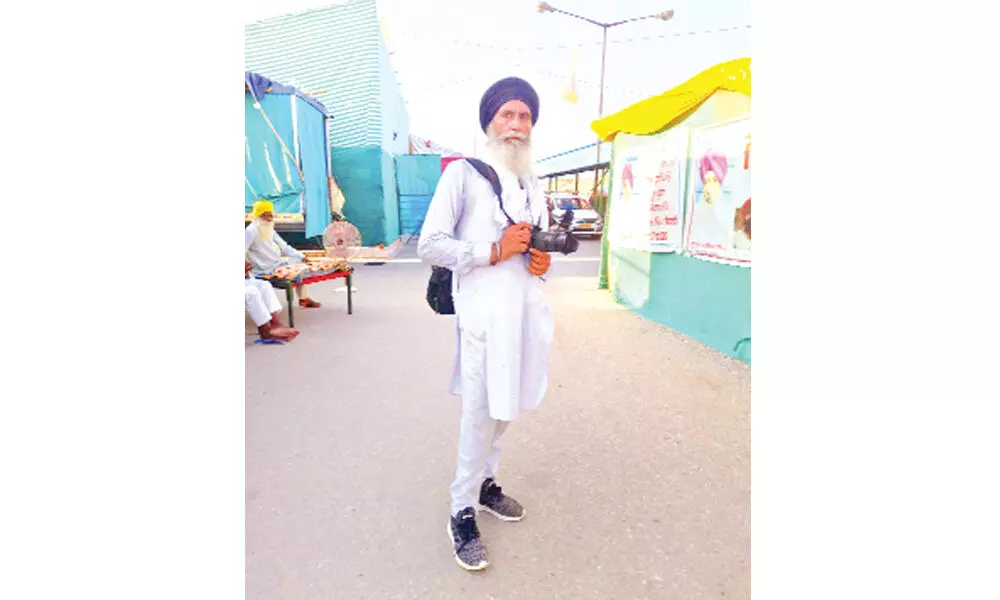A tireless shutterbug among protesting farmers
Hailing from Barnala district of Punjab, Jagdev Singh has been capturing the faces and landscape of the ongoing farmers protest with his camera since November 25, 2020
image for illustrative purpose

(Haryana-Delhi border): The ongoing resistance by farmers against the latest farm laws will be completing 10 months this week with many continuing with their protest at border sites of Singhu-Kundli border, Tikri border, Ghaziabad and Jharoda Kalan areas.
Such is the story of Jagdev Singh, a 55-year-old protestor, who has found a unique way to express his meaning of resistance. Hailing from Barnala district of Punjab, Jagdev has been capturing the faces and landscape of the ongoing farmers protest with his camera. A former landless farmer, Jagdev decided to join his fellow camaraderie on November 25, 2020, and came to the borders of Delhi in solidarity to demand the roll back of the farm laws.
For the last 10 months, Jagdev has been capturing over 100 pictures a day at the protest sites and usually pedaling bicycle his way through the border areas. With over 80 percent handicap from left leg, the shutterbug of Singhu Border became well known amongst his peers for capturing the essence of the farm laws protest. Jagdev started his career at his native city as a professional photographer over 30 years ago but had to shut down the shop in the early 2000s due to financial losses. He then borrowed land and attempted farming to feed his family of four.
"I met with an accident in 1993 and sustained severe injuries in my left foot. By early 2000s, I had to wind up my photography studio. I don't own a land, I would lease land, a few bighas, to cultivate and grow wheat and millet. Once these farm laws were announced, I decided to become a part of the movement and came to the Delhi borders. I have been here for almost 10 months now," Jagdev told Bizz Buzz.
Jagdev came to protest with only four pairs of clothes, his smart phone and a charger. He borrowed a camera from his friend and began capturing the faces and landscape of the protest.
"I realised my renewed passion for photography once I came here. In the past 10 months, I have purchased a DSLR camera and a cycle. I catch the portrait of each day of the protest, the faces of the people who have come to stay here at the site, leaving the comfort of their homes, cities and villages," he said.
His routine starts with morning prayer, followed by langar or meal at the protest site and then ferrying on his cycle to photograph the farmers and the villagers at the Singhu Border. One of the major challenges, according to Jagdev, is braving different elements of nature to keep up with his
passion of photography. In spite of being handicapped, he cycles throughout the day at Singhu Border and cover 15 kilometers of the protest site to capture the everyday routine of a protesting farmer.
After gaining much popularity of his photo portraits, Jagdev says he learnt the art of digital photography and editing in the last 6 months. Like his fellow protestors, Jagdev sleep on a cot in a tent and he is dependent on the unreliable electricity connection to charge his phone and camera.
"Whether it is excruciating heat of May-June or heavy rain lashes of July-September, we have braved it all. I think we will be celebrating another Baisakhi here at the borders protesting the laws. I am very proud of being a part of this movement, if I have to, will martyr myself for this cause," Jagdev said.
Jagdev has learnt to use social media to amplify his work and has garnered over 7,700 followers on Instagram in less than a month. His photographs capture the faces of farmers not only hailing from Punjab and Haryana but also Maharashtra, Andhra Pradesh and Tamil Nadu. From young lads holding placards of the protest, to women and men prepping meal at Singhu border, Jagdev has been commuting to all four farmers' protest sites on his cycle for the last 10 months.
"I miss my family, but this movement is a far bigger cause. I don't bother anyone with my physical challenge. I am simply glad that my photographs have become a mean to amplify our voices," he concluded.

